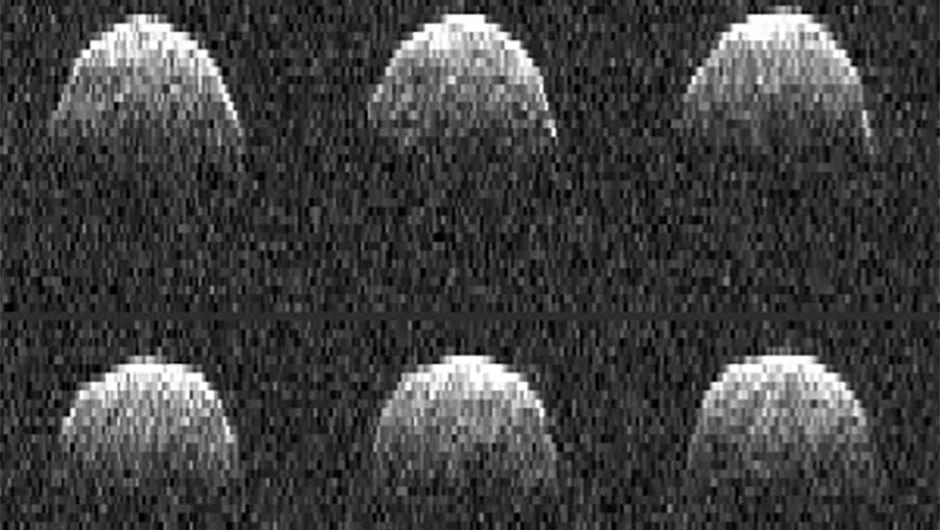Eleven years from now, the skies over Utah will bear witness to a spectacular homecoming.
High above the sandy desert floor a capsule will return from space, bathed in fire.
Tearing through the sky shrouded in a dazzling ball of light, the capsule will eventually parachute to the surface, where it’ll be whisked away to a secure facility at NASA’s Johnson Space Center.
Inside the bowl-shaped capsule will be a precious cargo: not humans, but a sample of the surface of an asteroid plucked from the space rock by a robotic arm.
The landing in Utah will be the climax of a daring mission, known as OSIRIS-REx, which is set for launch in 2016.
And as part of the mission, NASA is calling on amateur astronomers around the world to turn their own telescopes towards certain asteroids, in order to help scientists study these enigmatic objects.
The main aim of OSIRIS-REx (which stands for Origins Spectral Interpretation Resource Identification Security Regolith Explorer) is to retrieve a sample of regolith – the loose ‘soil’ found on the surfaces of some Solar System bodies – from (101955) 1999 RQ36, a near-Earth asteroid with a diameter of roughly 550m.
NASA scientists hope the sample will tell them about the composition and history of the asteroid, while measurements made by the spacecraft’s instruments should provide information about how much of an impact risk it poses to the Earth.
A large number of lower quality observations can be used to determine a higher quality result.
But it won’t just be the scientists who are scrutinising 1999 RQ36 and its ilk as part of the mission.
The team is also asking amateur astronomers to observe asteroids as part of a citizen science project known as Target Asteroids!
“In order to learn more about the entire asteroid population, we must be able to place 1999 RQ36 in context,” says Dolores Hill from the Target Asteroids! campaign.
“In an ideal world, we would like to know everything about our targets, such as their size, rotation rate, taxonomic type, colour and reflectivity.
To do this, we could get time on a large professional telescope and use that to make high signal-to-noise observations.”
The right stuff: what you need to help Target Asteroids!
Access to an 8-inch scope and CCD camera OR…
Access to an online robotic scope
Desire to study and image asteroids
Knowledge of calibrating and capturing images or a willingness to learn
Minor Planet Center observatory code
Target selection
With amateurs providing crucial contextual information about 1999 RQ36’s asteroid friends, it’ll be up to the NASA teams to examine the space rock up close.
There are several factors that make 1999 RQ36 an attractive target, says Jason Dworkin, the mission’s project scientist.
“There are over half a million asteroids, including more than 8,000 near-Earth objects.
And of those, 300 have orbits that you can get a sample-return mission to.”
However, just 27 of those 300 candidates are larger than 200m across.

“That’s important because asteroids smaller than 200m tend to be very fast rotators,” says Dworkin.
“Operations around an asteroid become difficult if its day is measured in seconds and also it’s likely that any loose regolith has been thrown off by its fast rotation.
So we need something big enough to retain regolith,” he says.
But, naturally, it’s not purely the logistics of capturing a sample that the NASA team has had to think about in selecting 1999 RQ36 as the target for OSIRIS-REx.
The asteroid is also of great scientific interest.
“We’re very interested in the origin of life,” explains Dworkin.
“The keys to that are in the most primitive objects, primitive meteorites like carbonaceous chrondrites.”
It turns out that only five of the 27 large asteroids right for a sample-return mission appear to have the same composition as the carbonaceous meteorites.
“Out of those five, 1999 RQ36 is the one we understand the best,” says Dworkin.
That understanding of 1999 RQ36 has come from a concerted professional observing campaign using telescopes in space and on the ground, says the mission’s deputy principal investigator Ed Beshore.
“We used the powerful Arecibo and Goldstone interplanetary radars to prepare shape models of the asteroid and to get more precise orbital ephemerides.
We know, for instance, that the asteroid is roughly spherical, with an equatorial ridge, and there doesn’t seem to be anything larger than about 10m on the surface.”

The team has also been able to confirm that there’ll be suitable material for the spacecraft to pick up.
“Measurements made with the radars indicate an abundance of regolith,” explains Beshore.
“In addition to radar, we used the Spitzer Infrared Space Telescope to measure the thermal infrared emissions from the asteroid.
This told us a lot about so-called thermal inertia, which also leads us to believe that there is surface regolith that will suit our sampling system.”
1999 RQ36 is probably not one solid lump of rock either, says Dworkin:
“Its density is about one, meaning it’s almost certainly a rubble pile.”
Yet despite all this scrutiny, 1999 RQ36 could still be holding on to some secrets. “
It may be an extinct comet, so we’ll be looking for outgassing plumes while we’re there,” he adds.
Space rock rendezvous
It will take around two years for OSIRIS-REx to make the journey to 1999 RQ36, with the current rendezvous date set for 15 October 2018.
Yet it’ll be a while after arrival before the spacecraft can go down to the asteroid’s surface.
The first thing the team will need to do is assess the enormous space rock and choose a suitable place to collect the valuable sample from.
They’ll also have to contend with the difficulties of flying a spacecraft close to an asteroid – not an easy business, says Beshore.

“When you’re orbiting Mars or another large body, gravity is the biggest force to be reckoned with and so is relatively easy to predict.
Around 1999 RQ36 we will be dealing with gravitational forces that are a tiny fraction of those found around larger objects.
Forces like solar radiation pressure and the thermal re-emission of radiation from the spacecraft have to be carefully factored in.
Combine this with the fact that we will be making passes over the surface of the asteroid as low as 250m as we perform reconnaissance on our proposed sample site.
You really have to understand the forces at play before you let your spacecraft get that close!”
The spacecraft will be in contact with the surface for less than five seconds
Reaching out
The instrument responsible for collecting a sample from the asteroid is known as TAGSAM – the Touch-And-Go Sample Acquisition Mechanism.
It will sit on the end of a 3m robotic arm that will reach out from OSIRIS-REx towards 1999 RQ36.
“TAGSAM will work by blowing compressed highly pure nitrogen gas to fluidise the regolith, then capture it in an air filter-like device,” explains Dworkin.
It’s hoped the device will capture at least 60g of material this way, but it could collect up to 2kg.
There will also be sample pads on TAGSAM to pick up small samples as a contingency.
“If all else fails we’re sure to capture something,” says Dworkin.
The team will get three chances to retrieve a sample; once it has been collected, the TAGSAM device will be placed inside its return capsule and sent on its long journey back to Earth.
“The purpose of the mission is to get a sample and characterise the context of that sample so we can understand it,” says Dworkin.
To that end, OSIRIS-REx will spend about 500 days with 1999 RQ36, carrying out scientific measurements and mapping its surface with its suite of cameras and laser altimeter.
OSIRIS-REx will also investigate a phenomenon known as the Yarkovsky effect.
“This involves the absorption of visible light and infrared radiation by the asteroid, and the re-emission of that energy as thermal infrared.
This re-emitted radiation acts as a tiny rocket thrust which can cause an asteroid’s orbit to migrate,” explains Beshore.
There are multiple collision solutions with this asteroid late in the 22nd century
That might not seem important, until one considers that a small nudge from the Yarkovsky effect could bring an asteroid close to the Earth.
“Indeed, 1999 RQ36 is one of the most hazardous asteroids that we know about,” adds Beshore. “There are multiple collision solutions with this asteroid late in the 22nd century.
We hope that the measurements we make of the Yarkovsky effect at 1999 RQ36 will help us better understand the threat this asteroid represents to the Earth.”
With OSIRIS-REx still four years from launch there’s plenty of time to capture images of the asteroids the team is interested in.
Now’s the chance to get onboard: with the right equipment, and the weather on your side, you could start helping NASA tonight!
The Expert: Dr Ed Beshore, Deputy Principal Investigator on the OSIRIS-REx mission

What questions do you hope to answer?
Our science team will be investigating questions about the dynamical history of the asteroid – where did it come from?
Has it undergone a long history of collisions?
Was it part of a larger body at some point in the past?
We will also be looking very carefully at the composition of the asteroid to try to relate its composition to the composition of meteorites we have in our collections here on Earth.
This will be an important effort — to tie together our studies of meteorites with our studies of asteroids.
We will also be attempting to tie together our ground-based observations of asteroids with observations that we will be taking in the vicinity of 1999 RQ36.
What part of the mission excites you most?
There is no doubt about it, it’s returning a sample. 1999 RQ36 is a carbonaceous asteroid. More specifically, we think it is representative of the CM chondrite meteorites [a class of meteorites] that we have in our collections here on Earth.
If so, we will be able to have an unaltered sample of one of the oldest objects in the Solar System. CM chondrites have the same elemental abundances as we find in the Sun.
We can infer from this that such asteroids have undergone very little processing since the beginning of the Solar System.
With a substantial sample of an asteroid like this we might be able to make some important strides in answering fundamental questions like: where did the water come from?
How did the organics, that are so important life, come to Earth?
It just doesn’t get any better than this for a scientist.
How likely is it that 1999 RQ36 will hit us?
Current estimates suggest that there is about a 1 in 1,800 chance of a collision with Earth late in the 22nd century.
While I would take those odds crossing the street, that’s quite high for an asteroid collision.
At 500m across, a collision of 1999 RQ36 with the Earth would do a considerable amount of damage.
It’s certainly worth us understanding the real threat that this asteroid poses.
Click here to find out more about Target Asteroids!
